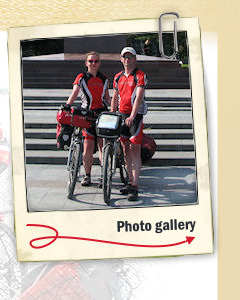In the wide steppe
Next day at 7:20 am we are already back on the bikes. It is a good road for cycling, almost flat. The landscape is changing – we have reached the Crimean steppe. The scent of grass and herbs is now replaced by the smell of cows ;-)
We stop to buy a kilo of sweet cherries form a solitary old woman. Peaches also look tempting, so I buy four of them. Juice is dripping down my hands and the taste? It is just peachy! I have never eaten such delicious peaches! The old lady asks where we come from. She says that life in Ukraine is hard: everything is expensive while the old-age pension is low. She earns some extra money selling "whatever the garden bears", but it is a hard way to earn a living. Winters have been mild recently, and in March - when all the plants are budding - frost comes. Therefore the crops are not as good as they used to be.
The steppe stretches to the horizon. A bit further the road turns, and wind starts blowing straight into our faces (unfortunately that will not change until the end of our stay in Crimea). The ride gets tough from this point – we cannot cycle downhill faster than 30 km/h, even in a forward bent posture, and the maximum speed on the flat is 15 km/h. A nightmare! Furthermore, the sun is straight above us all the time. At 4 pm we arrive at the town of Saky. Medical mud is extracted on a large scale from the local Saky lake, but its deposits are still substantial. The average lake depth is 1 meter, but underneath there is a 3-meter layer of mud, and below it – a 1.5 meter layer of salt. Extracted since the 17th century, salt was traded by the Tatars. In 1827 Saky became the first balneological resort of Tsarist Russia.
We stop to buy a kilo of sweet cherries form a solitary old woman. Peaches also look tempting, so I buy four of them. Juice is dripping down my hands and the taste? It is just peachy! I have never eaten such delicious peaches! The old lady asks where we come from. She says that life in Ukraine is hard: everything is expensive while the old-age pension is low. She earns some extra money selling "whatever the garden bears", but it is a hard way to earn a living. Winters have been mild recently, and in March - when all the plants are budding - frost comes. Therefore the crops are not as good as they used to be.
The steppe stretches to the horizon. A bit further the road turns, and wind starts blowing straight into our faces (unfortunately that will not change until the end of our stay in Crimea). The ride gets tough from this point – we cannot cycle downhill faster than 30 km/h, even in a forward bent posture, and the maximum speed on the flat is 15 km/h. A nightmare! Furthermore, the sun is straight above us all the time. At 4 pm we arrive at the town of Saky. Medical mud is extracted on a large scale from the local Saky lake, but its deposits are still substantial. The average lake depth is 1 meter, but underneath there is a 3-meter layer of mud, and below it – a 1.5 meter layer of salt. Extracted since the 17th century, salt was traded by the Tatars. In 1827 Saky became the first balneological resort of Tsarist Russia.




